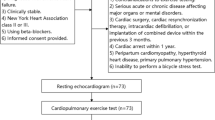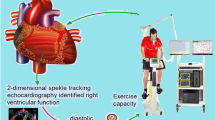Abstract
Objectives
Left ventricle function directly impacts left atrial (LA) conduit function, and LA conduit strain is associated with exercise intolerance in patients with heart failure with preserved ejection fraction (HFpEF). Pulmonary capillary wedge pressure (PCWP) before and during exercise is the current gold standard for diagnosing HFpEF. Post-exercise ΔPCWP can lead to worse long-term outcomes. This study examined the correlation between LA strain and post-exercise ΔPCWP in patients with HFpEF.
Methods
We enrolled 100 subjects, including 74 with HFpEF and 26 with non-cardiac dyspnea, from November 2017 to December 2020. Subjects underwent echocardiography, invasive cardiac catheterization, and expired gas analysis at rest and during exercise. Arterial blood pressure, right atrial pressure, pulmonary artery pressure, and PCWP were recorded during cardiac catheterization. Cardiac output, stroke volume, pulmonary vascular resistance, pulmonary artery compliance, systemic vascular resistance, and LV stroke work were calculated using standard formulas.
Results
Exercise LA conduit strain significantly correlated with both post-exercise ΔPCWP (r = − 0.707, p < 0.001) and exercise PCWP (r = − 0.659; p < 0.001). Exercise LA conduit strain differentiated patients who did and did not meet the 2016 European Society of Cardiology HFpEF criteria with an area under the curve of 0.69 (95% confidence interval, 0.548–0.831) using a cutoff value of 14.25, with a sensitivity of 0.64 and a specificity of 0.68.
Conclusions
Exercise LA conduit strain significantly correlates with post-exercise ΔPCWP and has a comparable power to identify patients with HFpEF. Additional studies are warranted to confirm the ability of LA conduit strain to predict long-term outcomes among patients with HFpEF.
Clinical relevance statement
Exercise left atrial conduit strain was highly associated with the difference of post-exercise pulmonary capillary wedge pressure and may indicate increased mortality risk in patients with heart failure with preserved ejection fraction, and also has comparable diagnostic ability.
Key Points
• Left atrial conduit strain is associated with exercise intolerance in patients with heart failure with preserved ejection fraction.
• Left atrial conduit strain during exercise can identify patients with heart failure with preserved ejection fraction.
• Exercise left atrial conduit strain significantly correlates with the difference of pulmonary capillary wedge pressure during and before exercise which might predict the long-term outcomes of heart failure with preserved ejection fraction patients.



Similar content being viewed by others
Abbreviations
- A:
-
Late mitral inflow velocity
- ACEi:
-
Angiotensin-converting enzyme inhibitors
- AUC:
-
Area under the curve
- BP:
-
Blood pressure
- CCB:
-
Calcium channel blocker
- CI:
-
Confidence interval
- CMR:
-
Cardiac magnetic resonance
- CO:
-
Cardiac output
- E:
-
Early mitral inflow velocity
- e′:
-
Early diastolic mitral annular velocity
- ESC:
-
European Society of Cardiology
- HFA:
-
Heart Failure Association
- HFpEF:
-
Heart failure with preserved ejection fraction
- HR:
-
Heart rate
- LA:
-
Left atrial
- LV:
-
Left ventricle
- LVEDD:
-
Left ventricular end-diastolic diameter
- LVEDS:
-
Left ventricular end-systolic diameter
- LVEF:
-
Left ventricle ejection fraction
- NCD:
-
Non-cardiac dyspnea
- NP:
-
Natriuretic peptide
- NT-proBNP:
-
N-terminal pro-brain natriuretic peptide
- NTUH:
-
National Taiwan University Hospital
- PA:
-
Pulmonary artery
- PAP:
-
Pulmonary artery pressure
- PCWP:
-
Pulmonary capillary wedge pressure
- PVR:
-
Pulmonary vascular resistance
- RA:
-
Right atrial
- RAP:
-
Right atrial pressure
- SD:
-
Standard deviation
- SV:
-
Stroke volume
- SVR:
-
Systemic vascular resistance
References
McDonagh TA, Metra M, Adamo M et al (2021) ESC Guidelines for the diagnosis and treatment of acute and chronic heart failure. Eur Heart J 42:3599–3726
Borlaug BA, Nishimura RA, Sorajja P, Lam CS, Redfield MM (2010) Exercise hemodynamics enhance diagnosis of early heart failure with preserved ejection fraction. Circ Heart Fail 3:588–595
Eisman AS, Shah RV, Dhakal BP et al (2018) Pulmonary capillary wedge pressure patterns during exercise predict exercise capacity and incident heart failure. Circ Heart Fail 11:e004750
Dorfs S, Zeh W, Hochholzer W et al (2014) Pulmonary capillary wedge pressure during exercise and long-term mortality in patients with suspected heart failure with preserved ejection fraction. Eur Heart J 35:3103–3112
Kasner M, Westermann D, Steendijk P et al (2007) Utility of Doppler echocardiography and tissue Doppler imaging in the estimation of diastolic function in heart failure with normal ejection fraction: a comparative Doppler-conductance catheterization study. Circulation 116:637–647
Paulus WJ, Tschope C, Sanderson JE et al (2007) How to diagnose diastolic heart failure: a consensus statement on the diagnosis of heart failure with normal left ventricular ejection fraction by the Heart Failure and Echocardiography Associations of the European Society of Cardiology. Eur Heart J 28:2539–2550
Nagueh SF, Smiseth OA, Appleton CP et al (2016) Recommendations for the evaluation of left ventricular diastolic function by echocardiography: an update from the American Society of Echocardiography and the European Association of Cardiovascular Imaging. J Am Soc Echocardiogr 29:277–314
Reddy YNV, Obokata M, Egbe A et al (2019) Left atrial strain and compliance in the diagnostic evaluation of heart failure with preserved ejection fraction. Eur J Heart Fail 21:891–900
Marino PN, Zanaboni J, Degiovanni A, Sartori C, Patti G, Fraser AG (2021) Left atrial conduit flow rate at baseline and during exercise: an index of impaired relaxation in HFpEF patients. ESC Heart Fail 8:4334–4342
Hoit BD (2018) Assessment of left atrial function by echocardiography: novel insights. Curr Cardiol Rep 20:96
Wu CK, Juang JJ, Chiang JY, Li YH, Tsai CT, Chiang FT (2018) The Taiwan Heart Registries: its influence on cardiovascular patient care. J Am Coll Cardiol 71:1273–1283
Ponikowski P, Voors AA, Anker SD et al (2016) 2016 ESC Guidelines for the diagnosis and treatment of acute and chronic heart failure: the Task Force for the diagnosis and treatment of acute and chronic heart failure of the European Society of Cardiology (ESC) developed with the special contribution of the Heart Failure Association (HFA) of the ESC. Eur Heart J 37:2129–2200
Pieske B, Tschope C, de Boer RA et al (2019) How to diagnose heart failure with preserved ejection fraction: the HFA-PEFF diagnostic algorithm: a consensus recommendation from the Heart Failure Association (HFA) of the European Society of Cardiology (ESC). Eur Heart J 40:3297–3317
Borlaug BA, Koepp KE, Melenovsky V (2015) Sodium nitrite improves exercise hemodynamics and ventricular performance in heart failure with preserved ejection fraction. J Am Coll Cardiol 66:1672–1682
Wu CK, Cheng JF, Huang CY, Chen ZW, Chen SY, Lin LY (2020) Iloprost and exercise haemodynamics in heart failure with preserved ejection fraction—the ILO-HOPE randomised controlled trial. Br J Clin Pharmacol 87:1165–1174
Lang RM, Badano LP, Mor-Avi V et al (2015) Recommendations for cardiac chamber quantification by echocardiography in adults: an update from the American Society of Echocardiography and the European Association of Cardiovascular Imaging. Eur Heart J Cardiovasc Imaging 16:233–270
Marino PN (2021) Left atrial conduit function: a short review. Physiol Rep 9:e15053
Khan MS, Memon MM, Murad MH et al (2020) Left atrial function in heart failure with preserved ejection fraction: a systematic review and meta-analysis. Eur J Heart Fail 22:472–485
Sugimoto T, Robinet S, Dulgheru R et al (2018) Echocardiographic reference ranges for normal left atrial function parameters: results from the EACVI NORRE study. Eur Heart J Cardiovasc Imaging 19:630–638
Maffeis C, Morris DA, Belyavskiy E et al (2021) Left atrial function and maximal exercise capacity in heart failure with preserved and mid-range ejection fraction. ESC Heart Fail 8:116–128
Rosca M, Lancellotti P, Popescu BA, Pierard LA (2011) Left atrial function: pathophysiology, echocardiographic assessment, and clinical applications. Heart 97:1982–1989
Sanchis L, Gabrielli L, Andrea R et al (2015) Left atrial dysfunction relates to symptom onset in patients with heart failure and preserved left ventricular ejection fraction. Eur Heart J Cardiovasc Imaging 16:62–67
Shah AM, Claggett B, Sweitzer NK et al (2015) Prognostic importance of changes in cardiac structure and function in heart failure with preserved ejection fraction and the impact of spironolactone. Circ Heart Fail 8:1052–1058
Jellis CL, Klein AL (2016) Heart failure with preserved ejection fraction: do you know your left atrial strain? Circ Cardiovasc Imaging 9:e004521
von Roeder M, Rommel KP, Kowallick JT et al (2017) Influence of left atrial function on exercise capacity and left ventricular function in patients with heart failure and preserved ejection fraction. Circ Cardiovasc Imaging 10:e005467
Backhaus SJ, Lange T, George EF et al (2021) Exercise stress real-time cardiac magnetic resonance imaging for noninvasive characterization of heart failure with preserved ejection fraction: the HFpEF-Stress Trial. Circulation 143:1484–1498
Sugimoto T, Bandera F, Generati G, Alfonzetti E, Bussadori C, Guazzi M (2017) Left atrial function dynamics during exercise in heart failure: pathophysiological implications on the right heart and exercise ventilation inefficiency. JACC Cardiovasc Imaging 10:1253–1264
Zimmermann P, Eckstein ML, Moser O, Schoffl I, Zimmermann L, Schoffl V (2022) Left ventricular, left atrial and right ventricular strain modifications after maximal exercise in elite ski-mountaineering athletes: a feasibility speckle tracking study. Int J Environ Res Public Health 19:13153
Maeder MT, Kaye DM (2009) Heart failure with normal left ventricular ejection fraction. J Am Coll Cardiol 53:905–918
Tschope C, Kasner M, Westermann D, Gaub R, Poller WC, Schultheiss HP (2005) The role of NT-proBNP in the diagnostics of isolated diastolic dysfunction: correlation with echocardiographic and invasive measurements. Eur Heart J 26:2277–2284
Lim TK, Ashrafian H, Dwivedi G, Collinson PO, Senior R (2006) Increased left atrial volume index is an independent predictor of raised serum natriuretic peptide in patients with suspected heart failure but normal left ventricular ejection fraction: implication for diagnosis of diastolic heart failure. Eur J Heart Fail 8:38–45
Funding
This work was supported in part by the National Science Council of the Republic of China (NSC107-2314-B-002 -265 -MY3). The funders of the study had no role in study design, data collection, data analysis, data interpretation, or writing of the report. National science and technology council 112-2314-B-002 -193 - and NTUH-VGH cooperation plan VN112-01.
Author information
Authors and Affiliations
Corresponding author
Ethics declarations
Guarantor
The scientific guarantor of this publication is Cho-Kai Wu.
Conflict of interest
The authors of this manuscript declare no relationships with any companies, whose products or services may be related to the subject matter of the article.
Statistics and biometry
No complex statistical methods were necessary for this paper.
Informed consent
Written informed consent was obtained from all subjects (patients) in this study.
Ethical approval
This study was proved by the institutional review board of the National Taiwan University Hospital (No. 201908057RINC).
Study subjects or cohorts overlap
None.
Methodology
• prospective
• case–control study
• performed at one institution
Additional information
Publisher's note
Springer Nature remains neutral with regard to jurisdictional claims in published maps and institutional affiliations.
Supplementary Information
Below is the link to the electronic supplementary material.
Rights and permissions
Springer Nature or its licensor (e.g. a society or other partner) holds exclusive rights to this article under a publishing agreement with the author(s) or other rightsholder(s); author self-archiving of the accepted manuscript version of this article is solely governed by the terms of such publishing agreement and applicable law.
About this article
Cite this article
Cheng, JF., Huang, PS., Chen, ZW. et al. Post-exercise left atrial conduit strain predicted hemodynamic change in heart failure with preserved ejection fraction. Eur Radiol 34, 1825–1835 (2024). https://doi.org/10.1007/s00330-023-10142-z
Received:
Revised:
Accepted:
Published:
Issue Date:
DOI: https://doi.org/10.1007/s00330-023-10142-z




